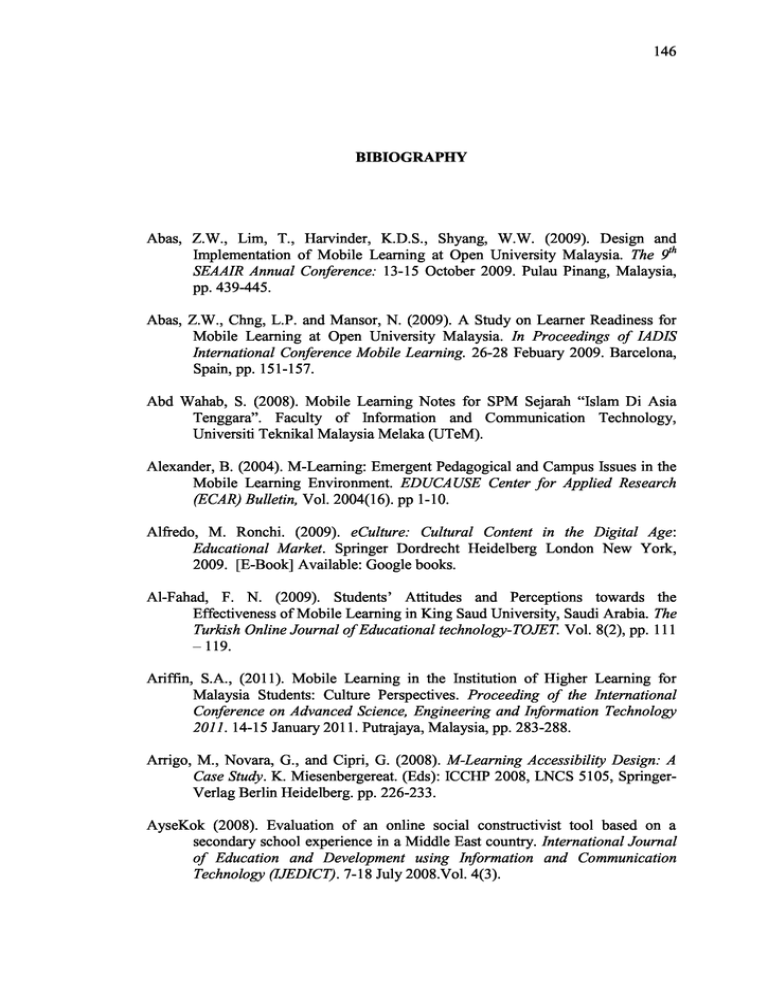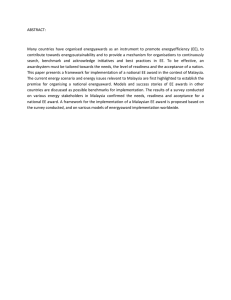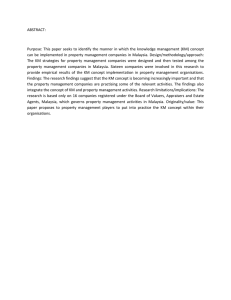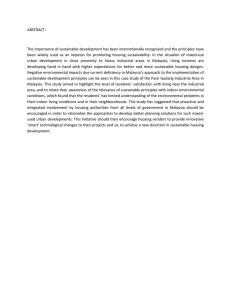BIBIOGRAPHY
advertisement

146 BIBIOGRAPHY Abas, Z.W., Lim, T., Harvinder, K.D.S., Shyang, W.W. (2009). Design and Implementation of Mobile Learning at Open University Malaysia. The 9th SEAAIR Annual Conference: 13-15 October 2009. Pulau Pinang, Malaysia, pp. 439-445. Abas, Z.W., Cling, L.P. and Mansor, N. (2009). A Study on Learner Readiness for Mobile Learning at Open University Malaysia. In Proceedings o f IADIS International Conference Mobile Learning. 26-28 Febuary 2009. Barcelona, Spain, pp. 151-157. Abd Wahab, S. (2008). Mobile Learning Notes for SPM Sejarah “Islam Di Asia Tenggara”. Faculty of Information and Communication Technology, Universiti Teknikal Malaysia Melaka (UTeM). Alexander, B. (2004). M-Leaming: Emergent Pedagogical and Campus Issues in the Mobile Learning Environment. EDUCAUSE Center fo r Applied Research (ECAR) Bulletin, Vol. 2004(16). pp 1-10. Alfredo, M. Ronchi. (2009). eCulture: Cultural Content in the Digital Age: Educational Market. Springer Dordrecht Heidelberg London New York, 2009. [E-Book] Available: Google books. Al-Fahad, F. N. (2009). Students’ Attitudes and Perceptions towards the Effectiveness of Mobile Learning in King Saud University, Saudi Arabia. The Turkish Online Journal o f Educational technology-TOJET. Vol. 8(2), pp. I l l -1 1 9 . Ariffin, S.A., (2011). Mobile Learning in the Institution of Higher Learning for Malaysia Students: Culture Perspectives. Proceeding o f the International Conference on Advanced Science, Engineering and Information Technology 2011. 14-15 January 2011. Putrajaya, Malaysia, pp. 283-288. Arrigo, M., Novara, G., and Cipri, G. (2008). M-Leaming Accessibility Design: A Case Study. K. Miesenbergereat. (Eds): ICCHP 2008, LNCS 5105, SpringerVerlag Berlin Heidelberg, pp. 226-233. AyseKok (2008). Evaluation of an online social constructivist tool based on a secondary school experience in a Middle East country. International Journal o f Education and Development using Information and Communication Technology (IJEDICT). 7-18 July 2008.Vol. 4(3). 147 Bajahzer, A., Al-Ajlan, A., Zedan, H. (2008). Exercise Services for E-learning in Higher Education with Open Source Software (MOODLE). IADIS International Conference, 9-11 April 2008. Algarve, Portugal, pp 51-58. Bhaskar, N.U. and Govindarajulu, P. (2008). A Design Methodology for Acceptability Analyzer in Context Aware Adaptive Mobile Learning System Development. International Journal o f Computer Science and Network Security 8(3), pp. 130-138. Blurton, C. (2002). New Directions o f ICT-Use in Education. UNESCO’s World Communication and Information Report. Brandi, K. (2005). Are You Ready to “MOODLE” ? Language Learning & Technology. Vol. 9(2), pp. 1 6 -2 3 . Available on : http ://llt.msu.edu/vol9num2/review 1/ Chai, L.G. and Poh, Y.N. (2009). E-learning in Malaysia: Success Factors in Implementing E-learning Program. International Journal o f Teaching and Learning in Higher Education Vol.20(2), pp. 237-246. Chaiprasurt, C., Esichaikul, V. and Wishart, J. (2011). Designing Mobile Communication Tools: A Framework to Enhance Motivation in Online Learning Environment. 10th World Conference on Mobile and Contextual Learning. 16-21 October 2011. Beijing, China. Chaka, C. (2009). From Classical Mobile Learning to Mobile Web2.0 Learning. Guy, R. (Ed.). The Evolution o f Mobile teaching and Learning. Santa Rosa, California: Informing Science Press (pp. 79-102). Cole, J. & Foster, H. (2008). Using Moodle, 2nd Edition. Published by O’Reilly Media, Inc., 1005 Gravenstein Highway North, Sebastopol, CA 95472. Davis, F.D. (1989). Perceived Usefulness, perceived ease o f use, and user acceptance o f information technology. MIS Quarterly, 13(3), pp. 319-339. Davis, F.D. (1993). User Acceptance of Information Technology: System Characteristics, User Perceptions and Behavioural Impacts. International Journal o f Man-Machine Studies (1993) 38, pp. 475-487. Dougiamas, M. & Taylor, P. (2003). Moodle: Using Learning Communities to Create an Open Source Course Management System. In D. Lassner & C. McNaught (Eds.), Proceedings o f World Conference on Educational Multimedia, Hypermedia and Telecommunications 2003 Chesapeake, VA: AACE. pp. 171-178. Douglas, M., Praul, M., and Michael J.L., (2008). Mobile Learning in Higher Education: An Empirical Assessment of a New Educational Tool. The Turkish Online Journal o f Education Technology-TOJET. Vol.7, No.3 ISSN: pp. 1303-6521. 148 E Costa, J.C., Ojala T., and Korhonen, J. (2008). Mobile Lecture Interaction: Making Technology and Learning Click. IADIS International Conference Mobile Learning 2008. 11-13 April, 2008. Algarve, Portugal, pp. 119-124. Ellis, Ryann K. (2009). Field Guide to Learning Management Systems, ASTD Learning Circuits. Georgiev, T., Georgieva, E., and Smrikarov, A. (2004). M-Leaming - a New Stage of E-leaming. International Conference on Computer Systems and Technologies. 17-18 June 2004. Rousse, Bulgaria, pp. 281-285. Georgieva, E., and Trifonova, A. (2006). The Influence of the Usage of e-leaming on the Students' Expectations about m-Leaming. Proceedings o f International Workshop in Learning Networks fo r Lifelong Competence Development, TENCompetence Conference. 30-31 March 2006. Sofia, Bulgaria. Georgieva, E., and Trifonova, A. (2006). Determining Student’s Readiness for Mobile Learning. 5th WSEAS International Conference on E-ACTIVITIES, 20-22 November 2006.Venice, Italy, pp.84-89. Gliem, J.A. & Gliem, R. R. (2003). Calculating, Interpreting, and Reporting Cronbach’s Alpha Reliability Coefficient for Likert-Type Scales. Midwest Research-to-Practice Conference in Adult, Continuing, and Community Education.Columbus, Ohio : Ohio State University. Goggin, G. (2009). Mobile Learning: The Significance o f New Mobile and Wireless Communications Technologies fo r Education. J. Zajda and D. Gibbs (eds.), Comparative Information Technology. Springer Science, pp. 65-77. Hashim, N.N. (2008). Learning Multiplication Table in Mobile. Faculty of Information and Communication Technology, Universiti Teknikal Malaysia Melaka (UTeM). Herrington, A., and Herrington, J. (2007). Authentic mobile learning in higher education. AARE 2007 International Educational Research Conference. 26­ 29 November. University of Notre Dame. Holzinger, A., Nischelwitzer, A., and Meisenberger, M. (2005). Mobile Phones as a Challenge fo r m-learning: Examples fo r Mobile Interactive Learning Objects (MILOs). Proceedings o f the 3r International Conference Pervasive Computing and Communications Workshops. 8 - 1 2 March. Koloa, Hawaii: IEEE, pp. 3 0 7 -3 1 1 . Houser, C., and Kinjo, T.P. (2005). Poodle: a course-management system for mobile phones./EE1# International Workshop on Wireless and Mobile Technologies in Education (WMTE’05).pp 211-215. Ismail, I.B., Sarah, S.M.J., and Idrus, R.M. (2009). Acceptance on Mobile Learning via SMS: A Rasch Model Analysis. International Journal o f Interactive Mobile technologies (UIM). Vol. 4(2), pp. 10 - 16. 149 Jacob, S. M., and Issac, B. (2007). Mobile Learning Culture and Effects in Higher Education. IEEE Multi disciplinary Engineering Education Magazine. Vol. 2(2), pp.19 —21. Jacob, S. M., and Issac, B. (2008).The Mobile Devices and its Mobile Learning Usage Analysis .Proceedings o f the International Multi Conference o f Engineers and Computer Scientists (IMECS) 2008.19-21 March 2008. Hong Kong. Jairak, K., Praneetpolgrang, P., and Mekhabunchakij, K. (2009). An Acceptance of Mobile Learning for Higher Education Students in Thailand. The Sixth International Conference on eLearning fo r Knowledge-Based Society. 17-18 December 2009. Thailand. Joseph, Rene Corbeil and Maria Elena Valdes-Corbeil (2007). Are You Ready fo r Mobile Learning1? EDUCASE Quarterly. 2:2007. pp 51-58. Krejcie, R.V. (1970). Determining Sample Size fo r Research Activities. Educational and Psychological Measurement, 1970, 30, pp. 607-610. Lodico, M.G., Spaulding, D.T. and Voegtle, K.L. (2006). Methods in Educational Research: From Theory to Practice. United States of America: A Wiley Imprint. Laouris, Y., and Eteokleous, N. (2005). We need an educationally relevant definition o f mobile learning. Available on: www.mleam.org.za/CD/papers/Laouris%20&%20Eteokleous.pdf Lu, X. and Viehland, D. (2008). Factors Influencing the Adoption of Mobile Learning. 19th Australasian Conference on Information Systems. 3-5 December 2008. Christchurch, New Zealand: ACIS, pp. 597 - 606. Mahendra, G., and Ela, G. (2011). Applicability of Mobile Learning Engine Moodle in Computer Application Course. Journal o f Information Technology Management, volume XXII (3). ISSN#1042-1319. Marguerite, L.K. (2009). A Model fo r Framing Mobile Learning. Mohamed Ally (Ed.). Mobile Learning Transforming the Delivery o f Education and Training. pp 45-67. Canada: AU Press. Mariam. M and John. W (2008). Why Does Malaysia Need to Consider Mobile Technology? A Review of Current Practices to Support Teaching and Learning with School-age Children. 2nd Asia Pacific Mobile learning & Edutainment Conference 2008 (APAC). 20-21 Nov 2008. Putra World Trade Centre, KL. Matthee, M.C., and Liebenberg, J. (2008).Teaching Systems Architecture by Using Mobile Learning Engine (MLE) As a Platform for a Mobile Learning Project. Proceedings o f the AIS SIG-ED IAIM 2008 Conference. 1 2 - 1 4 December 2008. Paris, France, pp. 1-6. 150 Mayorga, T.M.C. (2006). Learning Object fo r Mobile Learning: A Case Study in the Actuarial Science Degree. Current Developments in Technology-Assisted Education, 2006. pp 2095-2099. Meisenberger, M., and Nischelwitzer, A. K., (2004).The mobile learning engine (MLE) - a mobile, computer-aided, multimedia- based learning application. Multimedia Applications in Education Conference Mapec, 13-15 September 2004. Austria, pp. 52-58. McGriff, S. J., (2000). Instructional System Design (ISD): Using theADDIE Model. Instruction Systems, College of Education, Penn State University. Available on: www.iacmeonline.org/svstem/files/meeting/IACME Fall.../5.+ADDIE-1 .pdf Michelle, P., and Davide, D. (2009/ From E-leaming to Mobile Learning: New Oppunities. Mohamed Ally (Ed) Mobile learning: Transforming the Delivery o f Education and Training (pp 183-194). Canada: AU Press. Minovic, M., Stavljanin, V., Milovanovic, M., Starcevic, D. (2010). User-Centered Design of M-Leaming System: Moodle on the Go. Journal o f Computing Science and Engineering, Vol.4(l), March 2010, pp 80-85. Molenda, M. (2003). In search of elusive ADDIE model. Performance Improvement, 42(5), 1-4. Morgan, S. (2010). Internet Trends. Available on: http ://www.morganstanlev.com/institutional/techresearch/pdfs/Intemet Tren ds 041210.pd Morrison, G. R., Ross, S. M., Kemp, J. E., and Kalman, H. K. (2007). Designing Effective Instruction. (5th Ed). Hoboken, NJ: John Wiley & Sons, Inc. Naismith, L., Lonsdale, P., Vavoula, G., and Sharpies, M. (2006). Literature Review in Mobile Technologies and Learning. Future lab Series. Report 11. Available on: www.fliturelab.org.uk/research/lit reviews.htm Nedeva, V. (2005). The Possibilities of E-leaming, based on Moodle Software Platform. Trakia Journal o f Sciences, Vol. 3(7), pp 12-19. Park, S.Y. (2009). An Analysis of the Technology Acceptance Model in Understanding Students’ Behavioral Intention to Use e-Leaming. Educational Technology & Society, 12(3), pp.150-162. Paulus, I.S. (2009). Usability of E-Learning Portal and How It affects Students’ Attitude and Satisfaction, An Exploratory Study. Pacific Asia Conference on Information Systems (PACIS).\0 -\2 Judy 2009. Hyderabad, India. Pieri, M., and Diamantini, D. (2009/ From E-leaming to Mobile Learning: New Oppunities. Mohamed Ally (Ed) Mobile learning: Transforming the Delivery o f Education and Training (pp 183-194). Canada: AU Press. 151 Poon, W.C., Low, L.T., and Yong, G. F. (2004). A Study of Web-based Learning (WBL) Environment in Malaysia The International Journal o f Educational Management, 18(6), pp. 374-385. Poon, W.C., and Koo, A.C. (2008). Emerging Issues & Developments in Mobile Learning. 2nd Asia Pacific Mobile learning & Edutainment Conference 2008. 2 0 - 2 1 November 2008. Kuala Lumpur, Malaysia. Sahilu, W., Wan Admad, W.F., and Haron, N.S. (2010). University Students Awareness on M-Leaming. World Academy o f Science, Engineering and Technology Issue 62. 24 - 26 February 2010. Penang, Malaysia, pp. 787 791. Saipunidzam, M., Noor Ibrahim, M., Abd Malek Foad, M.D., and Mohd Taib, S. (2008). Open Source Implementation of M-Leaming for Primary School in Malaysia. International Journal o f Social Sciences.V ol. 3(4), pp. 309 - 313. Saipunidzam, M., Noor Ibrahim, M., and Mohd Taib, S. (2010). M-leaming: A New Paradigm of Learning Mathematics in Malaysia. International Journal o f Computer science and Information technology (IJCSIT). Vol.2(4), pp. 76 86 . Sek, Y.W., Lau, S.H., Teoh, K.K., Law, C.Y., and Shahril Parumo (2010). Prediction of User Acceptance and Adoption of Smart Phone for Learning with Technology Acceptance Model. Journal o f Applied Sciences. 10(20), pp. 2395 - 2402. Selim, Hassan M. (2003). An Empirical Investigation of Student Acceptance of Course Websites. Sharpies, M., Taylor, J., and Vavoula, G. (2005). Towards a Theory of Mobile Learning. Proceedings o f mLeam 2005 Conference. 25-28 October 2005. Cape Town, South Africa. Singh, D., and Zaitun, A.B. (2006).Mobile Learning in Wireless C\assrooms.Malaysian Online Journal o f Instructional Technology (MOJIT), 3(2), pp. 26-42. Som Naidu (2006). E-Learning: A Guidebook o f Principles, Procedures and Practices. Common wealth Educational Media Center for Asia, New Delhi. Tamimuddin, M. (2007). Mengenal Mobile Learning (M-Leaming). Available on: http://mtamim.files.wordpress.com/20Q8/12/mleam tamim.pdf Wafa’N, M., and Awatif, M. A-A-S. (2009). University Students’ Attitudes towards Cell Phone Learning Environment. International Journal o f Interactive Mobile Technologies (HIM). Vol. 3(4), pp. 35 - 4 0 . 152 William H. Rice IV (2006). Moodle E-Learning Course Development. A complteguide to successful learning using Moodle. Packet Publishing Birmingham-Mumbai. Woodill, G. (2011). The Mobile Learning Edge: Tools and Technologies fo r Developing your Team. The McGraw-Hill Companies, Inc. Wong, H.C. (2008). A Study on the learner readiness toward mobile learning and the effectiveness o f mobile learning application in motivating learning and enhances understanding. Universiti Teknologi Malaysia. Xhafa, F., Caballe, S., Rustarazo, I., and Barolli, L., (2010). Implementing a Mobile Campus Using MLE Moodle. 2010 International Conference on P2P, Parallel, Grid, Cloud and Internet Computing. 4-6 Nov 2010. Fukuoka, Japan, pp 207-214. Yordanova, K. (2007). Mobile Learning and integration of advanced technologies in education.International Conference on Computer Systems and Technologies - CompSysTech ’07.14-15 June 2007, University of Rousse, Bulgaria.pp 231­ 236. Zurita, G., Nussbaum, M., and Shaples, M. (2003). Encouraging face-to-face collaborative learning through the use o f hand-held computers in the classroom. Chittaro, L. (Ed.): Mobile HCI 2003, LNCS 2795, pp. 193-208, 2003. Springer-Verlag Berlin Heidelberg.





